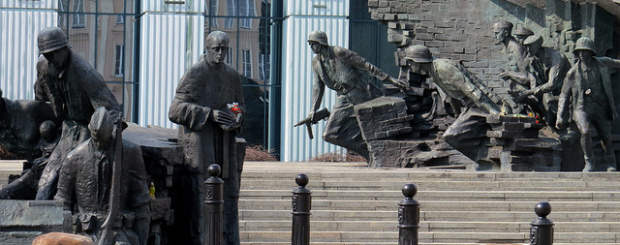11 New Museums In Poland That Are A Must See
For the history buff and the art lover to the casual traveler – Poland is teeming with incredible new museums to discover.
On October 28, 2014 POLIN: The Museum of the History of Poland Jews officially opened its permanent exhibit. This breathtaking museum is just the latest to open in Poland. Over the past decade Poland has seen a proliferation of state of the art museums dedicated to history, art, and social movements. Let’s take a look at 11 of the most specular new museums Poland has to offer. These new museums are just one of the innumerous advancements Poland has made over the past 25 years. #PolskaFree25
POLIN

As mentioned, POLIN is the newly opened Museum of the History of Polish Jews. Rather than solely focusing on the Holocaust, POLIN explores the over 1,000 year history of Jews in Poland.
Did you know that of the 14 million Jews in the world, 9 million trace their ancestry to Poland?
Polish President Bronislaw Komorowski declared during the grand opening of the Polin permanent exhibit: “It’s impossible to understand the history of Poland without knowledge of the history of Polish Jews. The reason is not just the centuries of Jewish presence in Polish lands, but also the significant role played by the Jewish community in many spheres of Polish life: in economy, culture and in science. It is equally impossible to understand the history of Jews without knowledge of Polish history. The reason is not just the centuries of mutual diffusion of the Jewish and Polish worlds and not just the centuries of being neighbors, but also the fact that by the end the 18th century, when Poland was about to disappear from the maps, a vast majority of European Jews lived within its borders.”


Warsaw Uprising Museum

The Warsaw Uprising Museum has set the standard for museums in Poland. Since opening in 2004 on the 60th Anniversary of the Warsaw Uprising, the museum has been described as “one of Poland’s best museums” “arguably the city’s finest museum” and “one of the most moving and well done interactive museums you can visit.” The museums tell the history of the Warsaw Uprising, a 63 day long struggle waged by the Polish underground Home Army against Nazi Germany from August 1 – October 3, 1944. The museum includes such features as a mock sewer which insurgents used to move around the occupied city as well as a replica of a B-24 Liberator aircraft which dropped supplies and munitions to fighting Warsaw. For the past decade this museum has been the talk of the town, and it continues to be as the museum enters into new initiatives, such as the recent feature film the museum as produced “Warsaw Uprising” which will be screened in New York, Los Angeles and Washington DC in the coming weeks.
Fryderyk Chopin Museum

The Fredrick Chopin Museum in Warsaw was established in 1955, however it underwent a complete renovation in 2010 during which a state of the art multimedia exhibition was installed. Featuring an open floor plan and interactive displays, the museum brings to life the music of one of Poland’s greatest sons. Described as “very clean and modern” the Chopin Museum is “a beautiful and insightful tribute to Poland’s greatest composer.” Great for children and adults alike.
European Solidarity Center

The European Solidarity Center is first and foremost a testament to the victory of the Solidarity Movement. The permanent exhibit covers the history of Poland under Communism, as well as what led to the rise of the Solidarity movement. It also illustrates the activities of Solidarity, the crackdown and martial law that followed, and ultimate victory over Communism. In addition to the exhibit, the center hosts a library as well as archives open to the public, meeting spaces for conferences and other events. Situated at the former Lenin Shipyards in Gdansk where the Solidarity Movement was born, the ESC design was inspired by its surroundings. Described as a “world class museum” with ” amazing storytelling.” One foreign visitor duly remarked, “We easily forget what the Poles went through, but this Museum really is an eye opener for all of us.”

MOCAK

Krakow has long been renowned for its art. Housing such works as the Wit Stwosz Alter, Wyspianski’s stained glass windows and Da Vinci’s Lady with an Ermine, Krakow offers plenty for the art connoisseur to see. But as of late Krakow has more than just traditional artworks on display. Since 2011, The Museum of Contemporary Art “MOCAK” also calls Krakow home. MOCAK is the first modern art museum in Poland, and with over 4,000 meters squared of exhibition space, it has plenty of space to showcase modern artwork. Described as, “a great facility in terms of design and layout. It’s what a contemporary art museum should look like” and “sets a new standard for what a museum is and can be.” Interestingly enough, the museum is located on parts of the former factory belonging to Oscar Schindler.


Oscar Schindler Factory Museum

Oscar Schindler and his factory, whose story was made famous by Steven Spielberg’s Schindler List (1993) is located in Krakow adjacent to MOCAK. The factory building now houses a branch of the Historical Museum of the History of Krakow. The museum recounts wartime in Nazi occupied Krakow 1939-1945. Opened in 2010, the museum is now considered by many visitors as a must-see destination while in Krakow. As visitors walk through the factory they see the progression of time, from 1939 when mobilization orders are issued for Polish soldiers, to the arrival of Nazi occupiers , issuing of Nazi decrees, the persecution of the Polish and Jewish populations, establishment of a ghetto and onwards. “Offering a stark insight into the occupation of Krakow” the museum “depicts the whole vibrant city as a victim of the Nazis.”
Rynek Underground

Rynek Underground is another branch of the Historical Museum of the City of Krakow. It is located directly below the main market square of Krakow, and is centered around a multimedia exhibit entitled “In the footsteps of Krakow’s European identity” which through the use of holograms, fog and other audio-visual enhancements strives to recreate the atmosphere that one would have experience at Krakow’s market square during the Middle Ages. Opened in 2010, it is described today as an “underground treasure” and “a walk into the past.” Who knew what you could find right below your very feet.



Palmiry – The National Memorial Museum

To Poles, the word Palmiry invokes the image of a wooded killing field. For it is here, in the Kampinos Forest near the small village of Palmiry, on the outskirts of Warsaw that the Nazis murdered Polish political leaders, intellectuals, civil servants and famous citizens. From senators and mayors, to athletes and Olympians, here lie Poland’s elite murdered by the Nazi’s during Aktion AB. Today a new visitor’s center stands beside the cemetery. Opened in 2011, the museum tells the story of not only the killings but also the rich history of the surrounding forests. Under the partitions, when Poland lost its freedom for 123 year, the Kampinos Forest often served as a staging area for Polish insurrection fighter due to its proximity to Warsaw. The museum is regarded as a “small exhibit which can pack a huge punch.”
Copernicus Science Center

The Copernicus Science Center is less of a museum and more of a hands on scientific learning center. Built on the bank of the Vistula river in Warsaw, the center features robots, experiment stations, interactive exhibits and an outdoor discovery garden. The center has displays geared towards different ages groups, a “Heavens of Copernicus” planetarium for visitors to enjoy and a large rooftop garden. What has been labeled as, ” unquestionably the very best science center in Europe” is certainly worth a visit.
Villa Oksza

A new museum from 1895. Yes – it’s possible. The historic Villka Oksza was transformed into a branch of the Tatra Museum in Zakopane in 2011. This museum proves that even without multimedia displays, it is still possible to make an informative and attractive museum. The villa was designed by Stanislaw Witkiewicza in the traditional Zakopane style and now houses the Gallery of 20th Century Art of the Tatra Museum.
Museum of the Home Army

Housed in a meticulously renovated railway building with a stunning glass atrium, the Museum of the Home Army in Krakow promotes knowledge about the Polish Underground Movement and its armed forces. A movement which was one of the largest underground movements and which organized the largest single operation by a partisian organization in World War II, the Warsaw Uprising. The museum is said to have, “heaps of brilliantly displayed information” and offer “a fascinating trip through history, and Polish identity.”
Coming soon!
Thats not it folks! There are several museums under construction which, once completed, will add to this already incredible repetoir of new museum in Poland.
World War II Museum
This museum is being built in Gdansk, the city where World War II broke out 75 years ago.
Katyn Museum

The Katyn Museum, established in 1993, is in the process of moving to a new location in the Warsaw Citadel which is being adapted to meet the needs of a new state of the art museum.




















